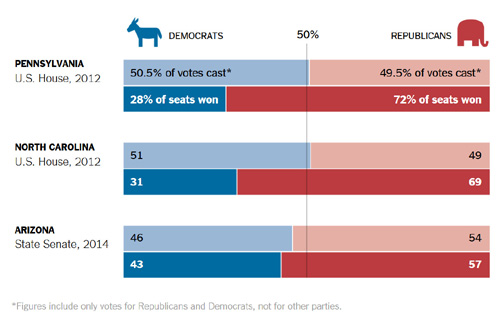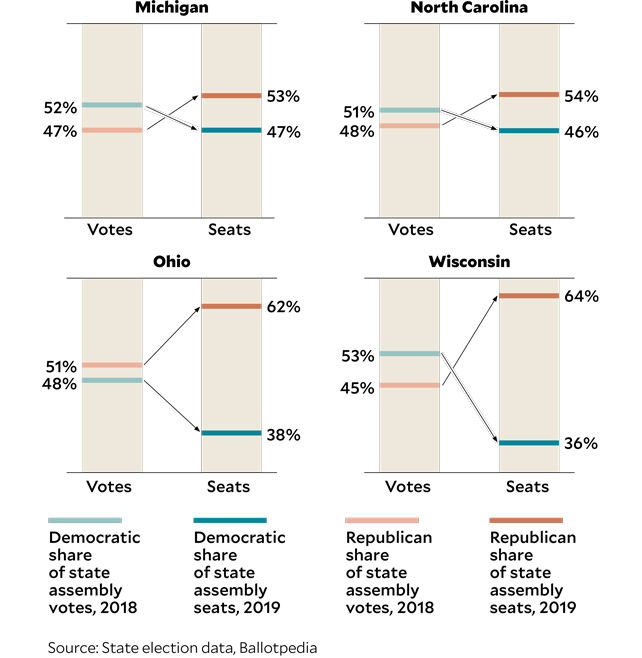Voters in the 2012 election didn't really vote for a Republican majority in the House of Representatives. But gerrymandered districts allowed them to retain control.
Political scientists point to two factors influencing this divergence: a redistricting process dominated by Republican legislatures, and even more so, the concentration of Democratic voters in urban enclaves.
Gerrymandering did matter. In nine states redistricted by Republicans, the Democratic vote share was well above the percentage of seats won, Mr. Goedert said. For instance, in North Carolina, Democratic House candidates won 51 percent of the vote but only 27 percent of the House seats. Where Democrats drew the lines, in Illinois, Maryland and Massachusetts, Democratic House delegations fared better than their vote totals, but not as drastically. This points to an inherent advantage for Republicans. In closely contested years, like 2012, the concentration of Democratic voters in cities has put them at a loss — and given House Republicans little reason to fear national opinion.
Source: "In Talks, House Majority Weighs Loyalty to Voters" By JONATHAN WEISMAN - NY Times - December 10, 2012
In the nation as a whole, Democratic candidates for Congress won 1.1 million more votes than Republicans, according to a tally of the popular vote kept by David Wasserman, the House editor of The Cook Political Report. But Republicans maintained their control of the House — making this one of a handful of elections in the last century where the party that won the popular vote for Congress did not win control of the House.
{The November 2012} Congressional elections were the first to be held in new districts that were drawn across the country after the once-a-decade process of redistricting, when many state officials, charged with redrawing their district maps to account for population shifts, indulge in carefully calculated partisan cartography aimed at giving their party an edge.
An analysis by the Brennan Center found that the new lines that took effect this year {2012} may have changed which party won in at least 25 House districts this year, and that they helped Republicans win a net gain of six more seats than they would have won under the old maps.
- Wisconsinites leaned Democratic when they went to the polls last month, voting to re-elect President Obama, choosing Tammy Baldwin to be their new United States senator and casting more total votes for Democrats than Republicans in races for Congress and the State Legislature.
But thanks in part to the way that Republicans drew the new Congressional and legislative districts for this year’s elections, Republicans will still outnumber Democrats in Wisconsin’s new Congressional delegation five to three — and control both houses of the Legislature.
- Pennsylvanians also voted to re-elect Mr. Obama, elected Democrats to several statewide offices and cast about 83,000 more votes for Democratic Congressional candidates than for Republicans. But new maps drawn by Republicans — including for the Seventh District outside Philadelphia, a Rorschach-test inkblot of a district snaking through five counties that helped Representative Patrick Meehan win re-election by adding Republican voters — helped ensure that Republicans will have a 13-to-5 majority in the Congressional delegation that the state will send to Washington next month.
- Republican-drawn lines also helped Republicans win lopsided majorities in other swing states Mr. Obama won: Democratic Congressional candidates won nearly half the votes in Virginia but only 27 percent of its seats, and 48 percent of the vote in Ohio but only a quarter of its seats.
Ohio’s Republican-friendly districts for state lawmakers were upheld last month by the Supreme Court of Ohio, which ruled in a 4-to-3 decision that the state’s Constitution does “not explicitly require political neutrality, or for that matter, politically competitive districts or representational fairness, in the apportionment board’s creation of state legislative districts” as long as the other legal requirements are met. {italics added}
Source: "How Maps Helped Republicans Keep an Edge in the House" By GRIFF PALMER and MICHAEL COOPER - NY Times - December 14, 2012
In the United States legislative system, district maps must be redrawn every 10 years, after each census, a process that legislators manipulate to gain advantage. Partisan redistricters stuff voters of the opposing party into a smaller number of districts, while spreading their own voters over a larger number of districts to eke out as many bare wins as possible. It is possible for a party to win more than half of the popular vote in a state, yet control fewer than one-third of the legislative seats. This is not a theoretical problem: Precisely such a thing happened in 2012 with the congressional delegations of Pennsylvania and North Carolina.
[I]n the Pennsylvania congressional election of 2012, Democrats won only 5 out of 18 congressional House seats, despite winning slightly more than half of the statewide vote. Democratic winners garnered an average of 76 percent of the vote, while Republican winners won 59 percent.
Source: "Let Math Save Our Democracy" By SAM WANG - NY Times - DEC. 5, 2015 -- Sam Wang is a professor of neuroscience and molecular biology at Princeton and the founder of the Princeton Election Consortium.

Votes Cast vs. Seats Won
Source: Sam Wang, Princeton University

More examples where Democrats have won the most votes, but Republicans took office.
Source: Ballotpedia via Mother Jones